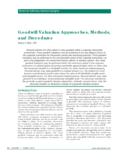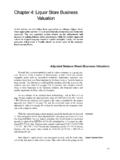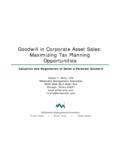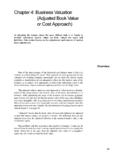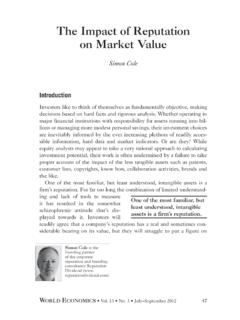Transcription of Update of Valuation Case Law - Capital Valuation Group, Inc.
1 Update of Valuation case Law March 2014 Prepared by Reginald A. Emshoff Capital Valuation Group, Inc. Ten East Doty Street Madison, WI 53703 Phone: (608) 257-2757 Fax: (866) 695-0870 remshoff@ca ANNOTATED case LAW Update Recent Developments in Business Valuation Table of Contents I. Valuation in General .. 3 A. Fair market value and the willing seller/willing buyer .. 3 B. Other standards of value .. 7 II. Approaches to the Valuation of a Business Enterprise .. 7 A. Understanding the Business.
2 7 B. Business Enterprise Valuation Methods.. 9 III. Specific Issues in the Valuation of a Business 16 A. Built-in Capital Gains of a C Corporation.. 16 B. Life Insurance Proceeds .. 18 C. Subsequent Events .. 18 D. S Corporations and other Pass-Through Entities .. 19 E. Goodwill .. 21 F. Buy-Sell Agreements and Transfer Restrictions .. 22 IV. Discounts .. 23 A. In general .. 23 B. Discount for lack of control .. 25 C. Discount for lack of marke tability .. 28 V. Specific Gift Tax Valuation Issues .. 30 A. Ineffective Transfers of Business Interests.
3 30 B. Indirect Gifts Beca use of Timing of Transactions .. 32 C. Prese nt Interests vs. Future Interest .. 33 D. Transfer Restrictions .. 36 2 March 2014 I. Valuation in General A. Fair market value and the willing seller/willing buyer The most common standard of business value is fair market value. It applies to valuations for estate, gift, and income tax purposes, and it is also the standard for valuations for divorce in Wisconsin. A determination of fair market value, being a question of fact, will depend upon the circumstances in each case .
4 No formula can be devised that will be generally applicable to the multitude of different Valuation issues arising in estate and gift tax cases. Often, an appraiser will find wide differences of opinion as to the fair market value of a particular stock. In resolving such differences, he should maintain a reasonable attitude in recognition of the fact that Valuation is not an exact science. A sound Valuation will be based upon all the relevant facts, but the elements of common sense, informed judgment and reasonableness must enter into the process of weighing those facts and determining their aggregate significance.
5 Revenue Ruling 59-60, sec. 1. Morrissey v. Commissioner of Internal Reve nue, 243 1145 (9th Cir. 2001) (also referred to as Estate of Kaufman by the Tax Court): (Background: Merrill Lynch had been engaged to value a minority interest in Seminole, a business, and had issu ed an opinion letter as to the value of its stock. Base d on this value, two shareholders sold their stock. The Tax Court reject ed these sales as not at arm s length and not similar to the estate s block of stock because they were smaller blocks. The Tax Court accepted the IRS value, less a 20% discount for lack of marketability.)
6 The Court of Appeals said .. The estate tax is levied not on the property transferred but on the transfer itself. Young Men's Chri stian Ass'n v. Davis, 264 47, 50, 44 291, 68 558 (1924). "The tax is on the act of the testator not on the rece ipt of property by the legatees." Ith aca Trust Co. v. United States, 279 151, 155, 49 291, 73 647 (1929). Consequently we look at the value of the property in the decedent's hands at the time of its transfer by death, 26 2033, or at the alternative Valuation date provided by the statute, 26 2032(a).
7 That the tax fa lls as an excise on the exe rcise of transfer underlines the point that the value of the transfer is established at that moment; it is not the potential of the property to be realized at a later date. Fair market value is "the price at which the property would ch ange hands between a willing buyer and a willing seller, neither being under any compulsion to buy or to sell and both having reasonable knowledge of relevant facts." 26 (b). The willing 3 March 2014 buyer and willing seller are to be postulated, not as a particular named X or Y, but objectively and impersonally.
8 Estate of McClatchy v. Comm'r., 147 1089, 1094 (9th ); Propstra v. United States, 680 1248, 1251-52 (9th ). As the Tax Court itself has held, the Commissioner cannot "tailor 'hypothetical' so that the willing seller and willing buyer were se en as the particular persons who would most likely undertake the transaction." Estate of Andrews v. Comm r., 79 938, 956, 1982 WL 11197 (1982). Actual sales between a willing seller and buyer are evidence of what the hypothetical buyer and se ller would agree on. See Estate of Hall v.
9 Comm r., 92 312, 336, 1989 WL 10688 (1989); 26 (b). No good reason exi sted [for the Tax Court] to reject the sales by Branch and Hoffman as evidence of the fair market value of Seminole stock on April 14, 1994. The sales took place close to the Valuation date. The sellers were under no compulsion to sell. There was no reason for them to doubt Weitzenhoffer's report of the Merrill Lynch Valuation . That the final report was delivered only in July did not undercut the weight of the formal opinion letter written in March.
10 The sellers had no obligation to hire another investment firm to duplicate Merrill Lynch 's work. (243 at 1147).. The Tax Court also engaged in the speculation that the Estate stock could be sold to a non-family member and that, to avoid the disruption of family harmony, the family members or Seminole itself would buy out this particular purch aser. The law is clear that assuming that a family-owned co rporation will redeem stock to keep ownership in the family violates the rule that the willing buyer and willing seller cannot be made particular.
